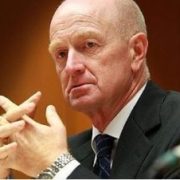For a lifetime central bank watcher, like myself, this was one for the record books.
Reserve Bank of Australia, Glenn Stevens, said last week that he welcomed a weak Australia dollar and that it probably had further to fall. To put gasoline on the flames, he added that there was room for the RBA to further lower interest rates, assuring that more weakness in the Aussie was assured.
The Australian dollar didn?t have to be told twice what to do. All bids for the troubled currency immediately vaporized, and it gapped down two full cents to the 90-cent level, a three-year low. When the Aussie broke a crucial support level at parity in the spring, I predicted that 80 cents was in the cards.
That forecast, bemoaned and lambasted at the time, is now looking increasingly likely. This is why I have been warning my Australian friends all year to pay for their summer vacations in advance while their currency was still dear.
What is far more important here is what the RBA moves means for the global economy. It certainly raises the stakes in the international race to the bottom, where every country tries to devalue their way to prosperity. During the Great Depression, this was known at the ?beggar thy neighbor? policy, a term I?m sure you have all heard a lot about. A cheaper currency means your exports now cost less, so customers shift business from your neighbors to you, boosting your economy.
In recent years, the US was winning that game. Then Japan took over the lead in November, with a yen (FXY), (YCS) that has fallen 25% since. Now, Australia has grabbed first place, with a 15% plunge since March. Who is the big loser in all this? Europe, where even the guy who runs the beach mini mart in Mykonos tells me his economy sucks because his currency (FXE) is grotesquely overvalued.
The sad thing is, I don?t think a weaker Aussie will help the Land Down Under very much, if at all. Their problem is not a price one for their commodities, but a demand one. Everything Australia sells is a commodity where prices are set by a global marketplace.
The slowing of China?s economy is the big driver here, as orders for Australia?s exports of iron ore, copper, and coal fall precipitously. Grains (DBA) sales are hurt by America?s bumper crop, which is killing prices. Fukushima demolished uranium exports (NLR). Australian offshore natural gas (UNG), at $16/btu, doesn?t stack up very well against US fracking gas at $3.50. Gold (GLD) is not exactly flying off the shelf either, with prices at one point this year down 33% from the highs.
There is another big factor, which no one but myself seems to me noticing. The slowdown in Chinese commodity demand is not a temporary affair, it is a permanent one. The government there is making every effort to shift the economy away from commodity consuming, metal bashing exports, to a more services oriented one.
This more suitably matches the Middle Kingdom?s own resource base, of which there are few, towards a higher rung in its own development. You will probably start to hear about this from other strategists, gurus, and research houses in about a year. It is momentous in its implications.
The RBA?s move caught many traders off guard, as they had already begun scaling into long Australian dollar positions, looking for an autumn rally. Mad Day Trader, Jim Parker, knew better, and was advising Aussie shorts up to the 94 cent level.
As for me, I?ll be selling every decent Aussie rally for the foreseeable future, until global commodity prices finally bottom, or Australia changes central bank governors, whichever happens first. I bet a lot of Australians right now prefer the latter over the former.







